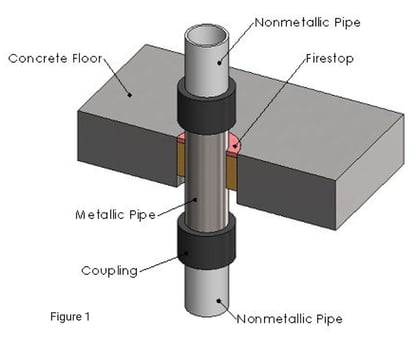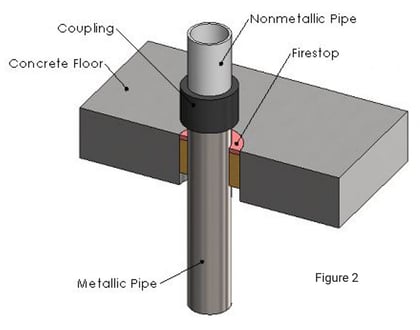Firestops for Dissimilar Pipe Materials
There are times when dissimilar piping materials need to be connected during new or retrofit construction work. Old materials being replaced might be difficult to source or it could be advantageous to use a more economically priced pipe material for sections of the line. Whatever the reason, be it supply or cost considerations, the immediate challenges to the plumber will be using the appropriate fittings while the arguably more important impact will be to those responsible for firestopping. When dissimilar materials are installed it becomes imperative to select the proper tested system that allows these specific materials to mate together.
The danger here is that an improperly designed firstop system will allow fire to bypass an otherwise fire rated wall or floor assembly. There are two main examples when we consider joining a metallic pipe to a nonmetallic pipe, and while similar behavior can be expected in walls we will examine the more critical case of a floor assembly. Figure 1 illustrates the example of a relatively short section of metallic pipe being positioned at the floor assembly and extending a minimal distance beyond each side of the assembly where two corresponding connections to a nonmetallic pipe occur. The reasoning behind this transition is that a metallic pipe will not burn and if the annular space between the pipe and opening is firestopped then there is nothing to worry about.
Unfortunately, it is the nonmetallic pipes we need to be concerned about! A fire will quickly burn through the wall of the nonmetallic pipe on the lower floor and the hot air and pressure from the fire will force flames through the metallic stub section of pipe like a chimney. The nonmetallic pipe on the upper story will soon be compromised as the flames erode it from the inside and ultimately allow fire to jump through the barrier. Sometimes to compensate for this type of scenario the metallic pipe will be continuous on the floor below and the nonmetallic pipe transition will occur at an upper story as shown in Figure 2. This type of installation will prevent the chimney effect, but there is still the potential for the metallic pipe to conduct enough heat to the junction point and ignite the nonmetallic pipe.
 Building codes recognize the danger these types of transitions may pose. There is language in Chapter 7 of the International Building Code (IBC) that requires connections between noncombustible and combustible penetrating items demonstrate that the fire-resistance integrity of the assembly is maintained. Similarly, there are requirements in Chapter 8 of the NFPA 101 “Life Safety Code” that mandate a minimum 36 inch separation between firestops installed in rated assemblies and any transition between noncombustible and combustible piping, unless this transition has been demonstrated not to reduce the fire-resistance rating. STI has developed firestop systems specifically for pipe transitions between noncombustible
Building codes recognize the danger these types of transitions may pose. There is language in Chapter 7 of the International Building Code (IBC) that requires connections between noncombustible and combustible penetrating items demonstrate that the fire-resistance integrity of the assembly is maintained. Similarly, there are requirements in Chapter 8 of the NFPA 101 “Life Safety Code” that mandate a minimum 36 inch separation between firestops installed in rated assemblies and any transition between noncombustible and combustible piping, unless this transition has been demonstrated not to reduce the fire-resistance rating. STI has developed firestop systems specifically for pipe transitions between noncombustible
and combustible materials, and STI Engineering Services can provide assistance for these potentially challenging applications.






